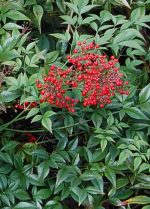 Heavenly bamboo is a semi-evergreen to evergreen shrub growing 3-8’ tall and a member of the barberry family, Berberidaceae, that also includes heavenly barberry, Oregon grape (Mahonia), and barronwort (Epimedium). It is not a bamboo but its canes and leaves are similar to those of bamboo leading to its common name. Native to Japan, China, and India, it was introduced into the US in 1804 as an ornamental for its attractive foliage and fruit but has escaped cultivation and become invasive in disturbed areas of the Southeastern states from Virginia to Texas because it reproduces easily from suckers and rhizomes, and produces large amounts of seed which are spread by birds. The leaves are bi to tri pinnately compound, 12-24” long, and turn reddish green in winter where the climate is mild. The white summer flowers appear in loose terminal panicles 8-15 inches long and are followed by bright red berries that persist into winter and attractive to birds. Cultivars are available that vary most significantly in size and fall coloration, and attempts are being made to produce ones that are sterile. The generic name, Nandina, comes from the Latinized Japanese name for the plant; the specific epithet comes from the Latin word domus meaning home plus the prefix –ic meaning characterized by, referring to the fact that the plant is cultivated.
Heavenly bamboo is a semi-evergreen to evergreen shrub growing 3-8’ tall and a member of the barberry family, Berberidaceae, that also includes heavenly barberry, Oregon grape (Mahonia), and barronwort (Epimedium). It is not a bamboo but its canes and leaves are similar to those of bamboo leading to its common name. Native to Japan, China, and India, it was introduced into the US in 1804 as an ornamental for its attractive foliage and fruit but has escaped cultivation and become invasive in disturbed areas of the Southeastern states from Virginia to Texas because it reproduces easily from suckers and rhizomes, and produces large amounts of seed which are spread by birds. The leaves are bi to tri pinnately compound, 12-24” long, and turn reddish green in winter where the climate is mild. The white summer flowers appear in loose terminal panicles 8-15 inches long and are followed by bright red berries that persist into winter and attractive to birds. Cultivars are available that vary most significantly in size and fall coloration, and attempts are being made to produce ones that are sterile. The generic name, Nandina, comes from the Latinized Japanese name for the plant; the specific epithet comes from the Latin word domus meaning home plus the prefix –ic meaning characterized by, referring to the fact that the plant is cultivated.
Type: Semi-deciduous to evergreen shrub
Outstanding Feature: Fruit, foliage
Form: Upright
Growth Rate: Slow to moderate
Bloom: Loose terminal 8-15” long panicles of white flowers in summer
Size: 3-8’ H x 2-4’ W
Light: Full sun to part shade
Soil: Average, medium moist, well-drained; may develop chlorosis in alkaline soil.
Hardiness: Zones 6-9
Care: Prune in the spring to keep compact
Pests and Diseases: None of significance
Propagation: Seed, half-ripe cuttings